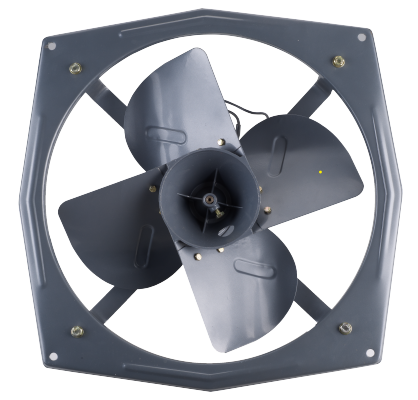An exhaust fan helps remove stale air, moisture, and odors from a room, improving ventilation. It is commonly used in kitchens, bathrooms, and other areas that need fresh air circulation
Specifications
Primary Function
Removes stale air: Extracts indoor air to maintain air quality by eliminating trapped humidity, smoke, or cooking odors.
Improves ventilation: Enhances airflow, providing fresh air to replace stagnant or humid air, and preventing mold or mildew buildup.
Moisture Control: Reduces excess moisture in bathrooms and kitchens, minimizing the risk of water damage and mold growth.
Design and Build
Compact Size: Designed for easy installation on walls or ceilings without taking up significant space.
Blades and Housing: Typically consists of rotating blades that draw air into a housing unit and expel it outside the building.
Materials: Most exhaust fans are made from durable plastic or metal with rust-resistant features for long-lasting use.
Noise Level: Many models are designed for quiet operation to minimize disruption in living or working spaces.
Power and Efficiency
Electric-powered: Exhaust fans run on standard AC electricity and typically consume low energy, making them an efficient option for constant ventilation.
Energy-efficient models: Some exhaust fans are designed to consume even less power, with low wattage motors and improved fan blades for better airflow.
Types of Exhaust Fans
Wall-mounted Fans: Installed directly on the wall to remove air from the room and expel it outside through ductwork. Ideal for small to medium spaces.
Ceiling-mounted Fans: Installed in the ceiling, often in bathrooms or kitchens, designed to vent moisture and odors upward.
Inline Exhaust Fans: Installed in the ductwork, away from the room, and used for larger spaces or applications requiring higher airflows.
Window Exhaust Fans: Designed for temporary installation in a window to vent air, often used in bedrooms or kitchens.
Airflow and Fan Speed
CFM (Cubic Feet per Minute): A key specification determining the volume of air the exhaust fan can move in one minute. Higher CFM ratings provide stronger airflow, suitable for larger or more humid rooms.
Variable Speed: Some models feature adjustable fan speeds, allowing users to choose the appropriate airflow level depending on the room’s ventilation needs.
Applications
Kitchen: Helps eliminate smoke, cooking odors, and excess moisture from cooking.
Bathroom: Removes humidity from showers and baths, preventing mold, mildew, and lingering odors.
Laundry Room: Removes humidity and odors associated with washing and drying clothes.
Attic: Helps improve airflow and reduce heat buildup in the attic, maintaining temperature balance.
Additional Features
Automatic Shut-off: Some exhaust fans include timers or sensors that automatically turn off the fan after a set period, saving energy.
Humidity Sensors: Certain models come with built-in humidity sensors that automatically activate when moisture levels exceed a certain threshold.
Lighting Integration: Some bathroom exhaust fans come with built-in lighting for added convenience.
Backdraft Dampers: Prevents outdoor air from entering the room when the fan is off, ensuring efficient operation.
Key Considerations
Room Size: Select a fan with the appropriate CFM rating based on room size and ventilation needs.
Installation Location: Consider whether the fan will be wall-mounted, ceiling-mounted, or window-mounted based on the room’s layout.
Noise Level: Opt for quieter models if the fan will be used in spaces like bedrooms or offices.
Maintenance: Ensure that the fan is easy to clean, with removable parts or filters for long-term performance.
